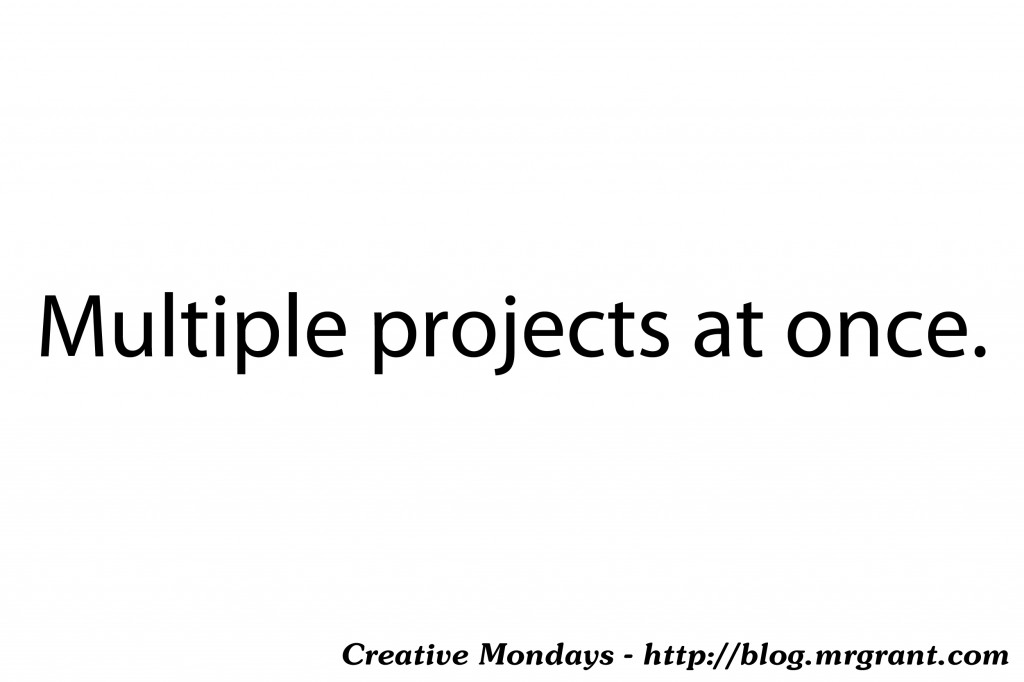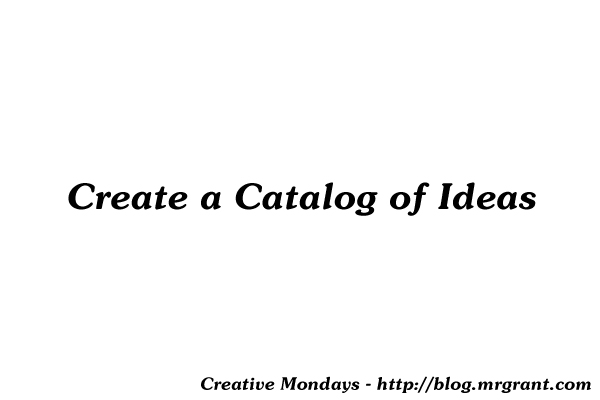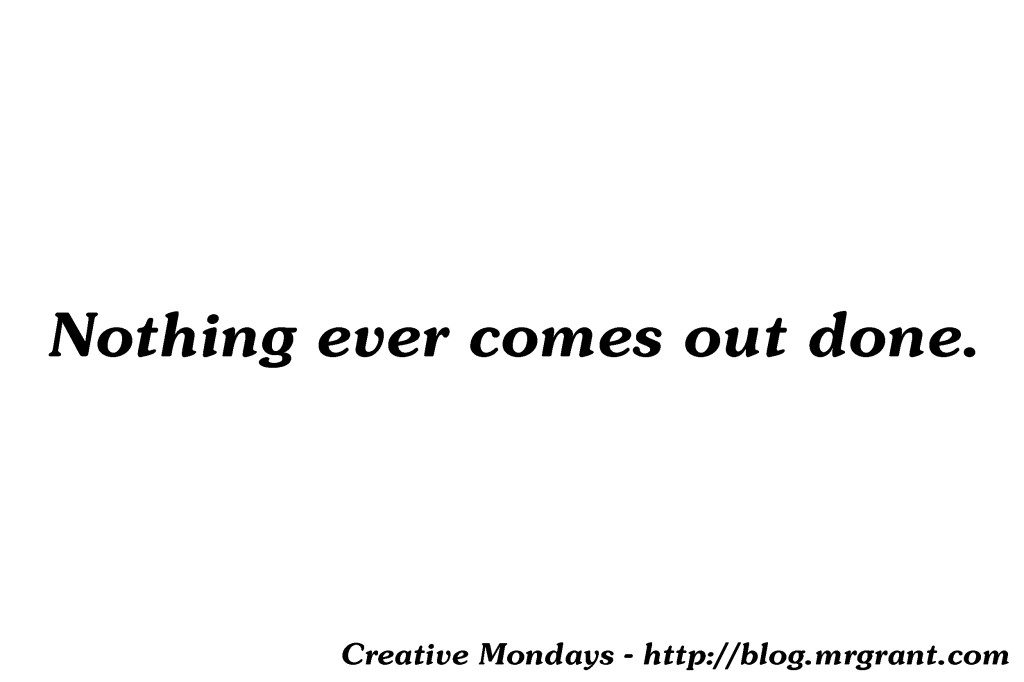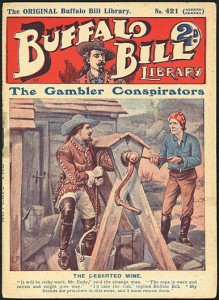Tag: ideas
Creative Mondays #035 – Multiple projects at once.

Today I want to talk about a creative thought that hits close to home. Having too many projects going at once. This is something I have a particularly rough time with. I usually have way too many creative projects going at one. At any given time I have ideas for audio podcast scripts, video podcast scripts, Throwing Toasters songs, completely new show ideas I want to develop and more.
I got the book Jim Henson’s Doodle Dreams and was looking through it and came across this quote by Jim Henson:
“Try to keep enough balls in the air so that when some fall to the ground, you’ve got others up there.”
I immediately loved that quote because I felt it really capsulated my feelings about how I work on creative projects. I read that as:
Be working on a bunch of projects so that if some of them don’t work out, you’ll still have others to work on.
The inherent danger in this, though, is that you have so many creative projects you are working on that none of them get done. This is certainly something I run into, however I like to think I prioritize creative projects pretty well. I will focus on one particular project and work on that one for awhile, but in the meantime I’ll be making small amounts of progress on other ideas. I find that working on multiple projects also keeps me from suffering burnout working too much on one project. Moving from project to project keeps the creativity flowing in my mind. Of course any creative project that someone is paying me to create takes precedence over personal ones that do not pay because, you know, money.
When working on multiple projects, also be careful about ‘bleed through’ unless it is intended. Bleed through is when elements from one project creep into another. I find this is more of an issue for me when I’m writing. I’ll look back through the stuff I’ve written and see that I’ve used the same names or same strings of dialogue. This is fine if I was writing multiple stories involving the same characters but often I am not. Bleed through won’t kill a project, it’s just something to keep an eye out for. In my case, I don’t want people saying, “He’s just writing the same story over and over again.” (As a side note to this, I do often write the same of similar jokes across multiple projects if they fit. I figure if one property hasn’t ‘made it’ and there’s a really good joke in it, there’s no reason not to use to make another property even better. That’s not bleed through as I’m doing it on purpose.)
When working on my own creative projects I often wear many hats: writer, producer, performer, editor, publisher. I can do all those jobs and often do. Though I’m not a rabid fan of Seth McFarlane, I do admire his work etheric on Family Guy. He created the show, writes it, performed in it and more. Back when there was a possibility of a Dr. Floyd television show, I was eager to do all those things should the show go forward. In my own projects now, I’m excited to do all those things.
Sometimes, I find, we MUST be all those things in our own creative work. At least until we are as famous as Seth McFarlane and we can have other people cover some of other aspect.
—
Are you an artist handling multiple creative projects at once? If so, how do you keep them all straight and get them all done? Let us know in the comments below. Have a great week!
Creative Mondays #008 – Create a Catalog of Ideas.

Here is the third installment of creative ideas I took away from seeing Joel Hodgson’s talk “Riffing Myself” in Northern California recently. I highly recommend going to see this show, even if you aren’t a fan of Mystery Science Theatre 3000. It’s a great show for anyone who is creative and, to me, gives great insight on how things, great things like Mystery Science Theatre 3000, are created. You can read the previous two blogs here: Don’t do what you don’t want to do & Nothing ever comes out done.
This final topic is actually a topic that I already have written on and was scheduled to come up soon here on the blog. I may touch upon it again in upcoming weeks, but I really waned to use Joel’s talk as a springboard to write on this idea. The idea of a creative idea book.
Joel told the story of taking a sculpture class in college where the instructor made all the students buy a big, black, hardbound sketch journal to use in the class. Joel thought the idea was a bit pretentious in that he felt he didn’t have any ideas worth putting into a hardbound journal, but it was a requirement so he picked one up. In his talk, Joel actually shows scans of the first two pages of the journal they are filled with ideas for different sculptures. Then he shows a scan of the third page where there are sculpture ideas on the top of the page and below is an, almost comical, mock up of a trick Joel wanted to create for his magic act. He then goes on to show other pages and, never again, were any of the pages adorned with sculpture ideas. From that page on it was ideas for things Joel wanted to create.
Joel calls this his Catalog of Ideas. He likens it to the old magician’s catalog he loved thumbing through as a kid. Full of wondrous things. Possibilities. Things that may happen of may not. His Catalog of Ideas was a storehouse of thoughts on things to create. Some he acted on immediately. Others lay dormant on the page, perhaps to be acted on in the future. He also spoke how, a lot of times, several different ideas in the Catalog would be combined together to create something completely different from anything else. He wrapped this part of the speech up by showing a picture of a closet, I’m assuming, in his office that is now full of large, black, hardbound sketch journals. His catalog of ideas. (Side Note: If you’re as big a fan of Joel’s as I am, wouldn’t you just love to thumb through those?)
So, a Catalog of Ideas. I have to admit, I don’t really keep one like the one Joel mentions in his talk. I think Joel is a lot more visual than I am where I prefer to write things out. Most times if I have an idea I will type it into the notes on my phone. Or I’ll just let it rattle around in my head until it’s so big I just have to act on it. I have recently been keeping a sort of idea journal. It has some ideas but it also has notes from meetings and classes, so it’s not strictly an idea journal. But you know what? I’m going to take it as a challenge to start a Catalog of Ideas of my own. I’ll let you know how it goes.
Again, I will plug Joel’s show. Go see it. For info visit his website here – www.JoelHodgson.com
—
Do you keep your own Catalog of Ideas? If so, how long have you done it? Tell us about it in the comments below. If you don’t keep one, how do you store all your creative ideas? Again, let me know below.
Creative Mondays #007 – Nothing ever comes out done

Last week I wrote about the concept of: Don’t do what you don’t want to do. It was an idea that had struck me when I went to see Joel Hodgson’s Riffing Myself show last weekend. I had two more thoughts from that show and I want to touch on the next one this week.
During Joel’s show he spoke a lot about the things that influenced him growing up as a kid. He talked about being captivated by the artwork of Roger Dean. If you don’t know, Roger Dean was an artist who is probably best known for doing the artwork for the covers of several albums for the band Yes. Those far out, alien looking, landscapes? Those were by Roger Dean. When Joel was younger Roger Dean released a book called Visions. It collected a bunch of artwork to that point in his career, but not only did the book include the artwork, it also showed the process of the artwork. From pencils sketches, through refinements, to the finished project, Roger showed step by step how things were made. Roger Dean also introduced Joel to the concept of kitbashing, or taking different parts from different model kits and combining them together to create something new. A technique Joel would later use to build robots for a certain television show.
One part of the book that really captured Joel’s attention was a page where Roger showed the process he took to create the logo for the band Yes. The swooping, sort of intertwined, logo that the band still uses to this day. That page, that showed the evolution of the logo from start to finish in a series of different photos of drawings was a lightbulb moment for Joel. Until that point, he had never realized that finished products aren’t just instantly created.
During his talk, Joel said the phrase, “If it’s not perfect, it’s not done.” I later talked to him about this statement and clarified clarified a bit saying that nothing comes out perfect the first time. It takes work to get something right. There’s a lot of trial and error in working to get something right.
I was happy for this clarification because the word ‘perfect’ opens up a lot of troubling doors, in my opinion. I’ll write about the ‘quest for perfection’ in the weeks to come. But the point Joel is making here is, as I said above, art just doesn’t come out perfect immediately.
If you’re writing a song, very rarely is it finished on first pass. Same with writing a book, play or script. Painting, sculpting, the list goes on. Creating art doesn’t just come out as a finished product.
I will take this stance however, it’s it okay to continue to create as you are refining your process. My example for that is my podcast The Radio Adventures of Dr. Floyd. If you listen to first season episodes and compare them to season eight episodes there is a world of difference. The pacing is tighter, the sound quality is better, it’s just an overall better show. That’s because there was a huge learning curve in how to edit and create an episode over those eight seasons. I learned a lot about editing audio and it shows. Also I think my writing improved from season one to season eight.
In sticking with the topic of ‘nothing comes out done,’ I wouldn’t say those season one episodes weren’t done. I worked on them just as hard as I did season eight episodes. I was just better at the work in those later years.
I think the takeaway here is that it takes some time to create art. Nothing ever comes out done
—
Is the idea of ‘nothing ever comes out done’ true in your creative work? How long does it take for you to finally say, “That’s done, I’m moving on to the next piece?” Let me know in the comments below.
